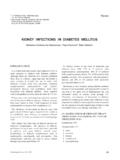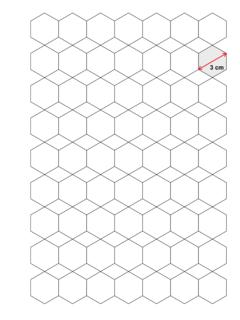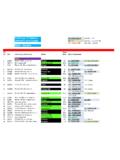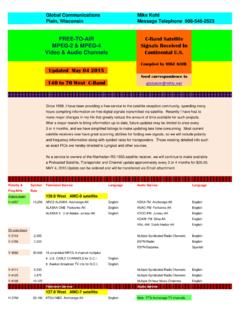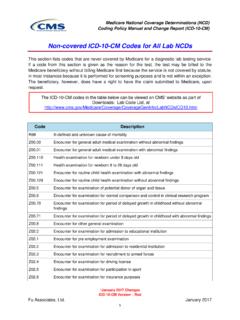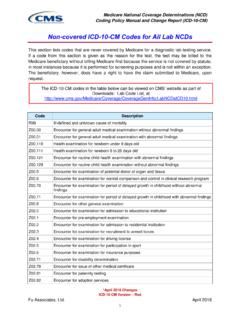Transcription of DERMATOLOGIC LESIONS IN DIABETES MELLITUS - idb.hr
1 EPIDEMIOLOGY OF SKIN LESIONS INDIABETES MELLITUSN umerous skin LESIONS are associated with either type1 or type 2 DIABETES MELLITUS , specific chroniccomplications of the disease, use of antidiabetic drugs,and certain endocrine and metabolic disorders thatcause secondary DIABETES OF DERMATOLOGICLESIONS IN DIABETES MELLITUST here is considerable uncertainty about thepathogenesis of the many cutaneous conditionsaffecting diabetic patients in no small part because ofour inadequate understanding of the metabolic basis ofdiabetes MELLITUS is no strict classification of skin LESIONS relatedto DIABETES MELLITUS .
2 Therefore grouping them underthe following headings will give us an idea aboutvarious types of skin LESIONS occurring in DIABETES . So,one would know what are the DERMATOLOGIC conditionsoccurring in a diabetic (1). DERMATOLOGIC LESIONS associated with but notspecific for DIABETES MELLITUS (disease markers) Pruritus Necrobiosis lipoidica diabeticorum Granuloma annulare Diabetic dermopathy Scleroderma-like syndrome Acanthosis nigricans Diabetic bullaeSkin alterations due to diabetic complications Diabetic foot Cutaneous infections associated with DIABETES - furunculosis- carbuncle- pyodermas- candidiasis- dermatophytosis Erythrasma Xanthomatosis Xanthelasma Pycomycetes Malignant otitis mediaDermatologic changes associated withneurovascular complications Macroangiopathy147 Diabetologia Croatica 31-3, 20021 Pathuri Skin Hospital.
3 Near Gokawaram Bus StandRajahmundryAndhra Pradesh, India2 Vuk Vrhovac Institute, University Clinic for DIABETES ,Endocrinology and Metabolic Diseases,Dugi dol 4a, HR-10000 Zagreb, CroatiaReviewDERMATOLOGIC LESIONS IN DIABETES MELLITUSC hilukuri Sreedevi1, Nikica Car2, Ivana Pavli -Renar2 Microangiopathy Diabetic neuropathyDermatologic complications of diabetestreatment with oral hypoglycemic drugs with insulinEndocrine syndromes with skin alterations anddiabetes MELLITUS Migratory necrolytic erythema in glucagonomaDermatoses that are more common in diabetesmellitus Perforating dermatosis Vitiligo Lichen planus Eruptive xanthomas Kaposi s sarcoma Bullous pemphigoid Dermatitis herpetiformis PsoriasisVARIOUS TYPES OF DERMATOLOGICLESIONS IN DETAILD ermatologic LESIONS associated with but
4 Notspecific to DIABETES MELLITUS (disease markers)PruritusGeneralized pruritus was once considered a typicalsymptom of DIABETES but its frequency is have failed to provide a statistical basis for thisbelief (2,3). A higher rate of pruritus is found in liverdiseases, uremia, parasitic infestation, endocrinedisorders (thyroid), malignant diseases, hemotologicand metabolic diseases, and as a side effect of somedrugs. Generalized pruritus is associated with diabetescomplications of chronic renal insufficiency,occasionally neuropathy (irritation of nerve endings canbe the cause).
5 High levels of urea in the blood causethe skin to itch. Candidiasis or dermatophytosis mayunderlie pruritus in diabetic patients. Anogenitalpruritus is often caused by candidiasis in diabeticpatients (4). Some fungal infections most commonly occurring indiabetics are jock itch, athlete s foot and itch appears as a red, itchy area that will spreadfrom genitals outward over the inside of the itch is more common in men than in athlete s foot occurs the skin between the toeswill become itchy and sore.
6 It may also crack, peel orblister. Ringworm is identified by ring-shaped, red scalypatches that can itch or blister. Ringworm can appearon the feet, groin, trunk, scalp or nails. Itching in thelegs in elderly diabetics is not a feature ofhyperglycemia but rather a manifestation of lubricants and low potency corticosteroidapplication should prove helpful. Necrobiosis lipoidica diabeticorumThe disease is very rare, occurring in 7% of diabeticpatients (5). These relatively asymptomatic lesionsare three times more common in women than in is one of the cutaneous markers of DIABETES .
7 At thetime of diagnosis 10% of the people will developdiabetes within 5 years or have abnormal glucosetolerance or history of the disease in at least one parent(6). The condition occurs at any age but it generallyfavors young adults at a mean age of 34 years. In insulinusers, the onset is considered to occur much earlierthan in type 2 diabetics or nondiabetics (7). Thelesions are characteristically found on the anterior andlateral surfaces of lower legs, in the pretibial andmedial malleolar region.
8 They may also be present onthe face, arms and trunk. There may be one or severallesions, either unilateral or bilateral. The lesion beginsas a small, dusky-red elevated nodule with a sharplycircumscribed border. It slowly enlarges to turn into aplaque of irregular outline, flattened, and eventuallydepressed as the dermis becomes more atrophic. The color turns more brownish-yellow except for theborder, which may remain red. Coalescing or enlarginglesions may in time encompass the entire anteriortibial area.
9 The epidermis is smooth or slightly scalyand atrophic. Delicate vessels can be seen through thesurface. The LESIONS may be anesthetic or havereduced sensation to pin prick and to fine touch due todestruction of cutaneous nerves (8).148C. Sreedevi, N. Car, I. Pavli -Renar / DERMATOLOGIC LESIONS IN DIABETES MELLITUSThe chronic LESIONS of necrobiosis lipoidicadiabeticorum (NLD)are indolent; shallow, oftenpainful ulcers frequently appear in long-standinglesions. In the early stages, NLD may resemblegranuloma annulare or sarcoid, but a well-developedplaque is characteristic and easily recognized.
10 Theprimary pathologic changes are in the lower dermis,where collagen is markedly altered with focal areas ofloss of normal structure, swelling, basophilia, anddistortion of the bundles (necrobiosis). Cross-striationsand diameters of collagen fibers are irregular. Althoughthe amount of collagen is actually decreased, therelative proportions of types I and III are cultured from skin LESIONS have beenreported to produce less collagen. There is also theloss and fragmentation of elastic fibers.

